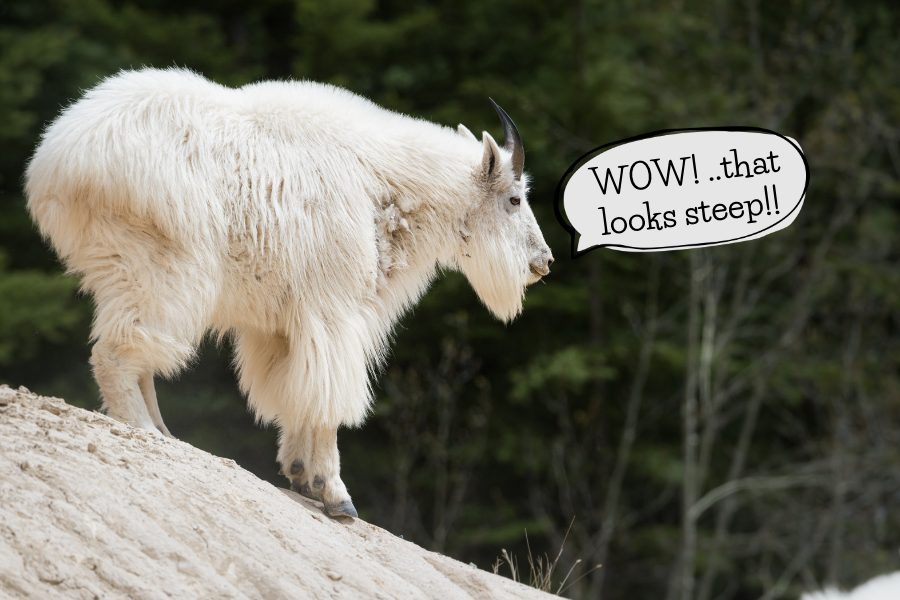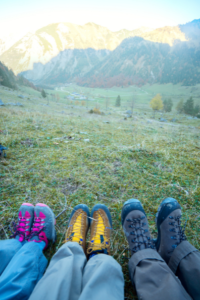Goat goals will help you get goat fit and stay fit …
We introduced our goat guide in August 2021 as we took on WalkingWomen. There are so many ways to describe the variety of hikes on offer – we wanted something simple, descriptive and fun. Our goats have received attention and many of our guests have asked questions; our Goat Guide ranks our walks in order of challenge. One goat being not that challenging, with four goats being the most challenging hike we offer. These are just a few of the recent questions we have had:
How fit do I need to be for goat 4?
I am comfortable with goat 1, but how do I progress to goat 3?
How can I get myself fitter to feel confident I won’t be left behind or slow down the group?
In response, we at WalkingWomen are launching Get Goat Fit for 2023 – to help us all keep fit over the winter , stay fit throughout the year and be ready to join walking holidays and feel it is the right choice for you. Some of our guides are also personal fitness trainers and they have been helping to share tips.
A tip from Collette “ Don’t ever be discouraged. The best thing to do is put on your walking boots and get outside. The best way to become walking fit is to get out and walk”
Soon our Get Goat Fit sessions begin – 1-3 day events to meet a guide, hear more about WalkingWomen and build confidence and test your own walking ability. You will also leave with tips to help you get fitter and stay fit. Keep an eye on our website and social channels. We will be announcing dates soon. And we will send out information to all subscribers. If you haven’t subscribed, please do.
We also bring you our Get Goat Fit Guide.

Track what you can do now and what you want to be able to do. Plan a simple exercise routine that you know you will be able to achieve. Make sure walking is part of your routine – use stairs, not lifts, walk to the shop for your pint of milk, walk and talk with friends instead of sitting, walk to visit a new place rather than driving, walk up stairs (if you have them) 10 times a day. Just Keep walking, and if you can, add swimming to your routine to help tone and increase flexibility or try yoga or pilates to build muscle strength, stamina and flexibility. We are introducing more walking and yoga holidays in 2023 for those who want to get more help toning and flexing.
Goats 3 and 4 are more about the ascents and descents and the type of terrain than the distance. So you need to be comfortable walking up and down hills and mountains. We never rush, so as long as you can breathe and have legs that are strong enough, you can do it.
The goals set out below are targets to aim for by week five of the plan. Work up slowly and pace yourself. You don’t want to push too hard and pick up an injury. You should be able to achieve the goals consistently in weeks five, six and seven. Week eight should be a ‘rest’ week at around 50% of the previous week. This is a guide only, and everyone will be starting from a different level of fitness, but if you manage to achieve the goal, you’ll be goat-fit and ready to enjoy the next walking holiday you join.

Try tracking your walking with the NHS Active 10 App, available on the NHS website.
Colette, WalkingWomen guide, shares thoughts on fitness and other top hiking tips to make life on the trail comfortable & enjoyable.
How Goat fit am I? – by Colette Stewart
When joining in with a group hike, how many of us questioned our own ability and fitness? Will I keep up? Will I slow down the group? Will I make it up the hills? These concerns are understandable; mostly, we all underestimate our own ability and fitness level, but then do we also sometimes overestimate it? This is where the doubt sneaks in, and our confidence takes a knock. But don’t be discouraged; this is when the best thing to do is just put on your walking boots and get outside. Because the best way to become walking (goat) fit is, well, basically, to get out and walk.
What does walk/hike fitness look like?
- Cardiovascular Fitness – do you get out of breath easily when you walk faster or up hills?
- Balance/Core Strength – do you wobble and stumble when walking on uneven or rocky ground?
- Strength – do you struggle to get up the steeper areas and bigger steps?
- Endurance/Stamina – can you keep walking for a full day, or do you start to flag after a couple of hours?
Wearing the right footwear

On a typical walk, you may walk on the tarmac, hard packed gravel, muddy single track, uneven surfaces (puddles and mud), ankle-height rocky tracks, knee-height rocky tracks, gradual ascent/descent, steep ascent/descent, ascent/descent with rocks/tree roots/mud.
Being walk fit is not only about cardio, balance, strength and endurance. It’s also about being confident when walking on a mix of challenging surfaces. Having comfortable, worn-in walking shoes or boots and getting to know how they perform on a mix of surfaces is equally important.
Do you know how to use walking poles correctly and safely?
Hiking poles reduce compressive forces on your knees by 25 per cent (Journal of Sports Science). They do this by redistributing load-bearing body weight to the arms and shoulders so that hiking poles reduce the impact on your knees. The added bonus is that you will also get a good upper arm and shoulder workout too! The use of walking poles, or even a single pole, will also increase your hill-climbing power and endurance. Poles also help with balance when crossing uneven ground or when crossing boggy areas, rivers and scree.
What’s on your back?
Carrying an ill-fitting or fashion-designed backpack can make for an unpleasant day out. In some cases, it will not only rub but can unbalance you on uneven ground. Make sure yours has a good wide waist belt; this will ensure the weight of the pack will be on your hips rather than your shoulders. The sternum strap is there to disperse the weight of the backpack; it will prevent your shoulders from getting sore and prevent the shoulder straps from sliding off your shoulders. The tighter the sternum strap is, the more weight is displaced.
What is training?
Training is about progressively increasing your body’s ability to do just that little bit more, giving it time to adapt, recover and come back stronger.
A mix of activities such as walking, jogging, cycling, swimming and racket sports will all increase your heart rate and improve your cardio fitness. Going to the gym or joining circuit training classes will go towards building a good level of strength and fitness.
But training for purpose is the key; if you want to be hike fit, then you need to hike.
Look for nature trails, and head for hills and mountains if there are any within your reach. Try to do some full-day hikes and, if possible, two consecutive days.
Wear your hiking boots, use your walking poles and, take your backpack; get used to your kit.
Exercise where and how?

You need to be able to fit exercise into your current lifestyle, we all have different barriers to exercise, and you need to set out a weekly plan which is achievable and manageable – something you can stick to. The aim of these sessions is to slowly improve your cardiovascular system, core strength and stamina; you will then have a solid base from which you can gradually increase your overall general fitness level.
Cross-training: This means taking part in at least two different forms of exercise in one session, such as walking, cycling, running etc.
Interval Training: Bouts of exercise interspersed with short rest intervals. So short bursts of harder exercise and then a short rest. For this, you could alternate between brisk walking or a jog for up to a minute and then return to a slower pace for a few minutes.
Strength Training: A simple strength program will adapt your body for more strenuous resistance training. It targets the major muscle groups, tendons, ligaments and joints to help prevent injury. Exercises you should include are squats, bench presses, overhead presses, leg presses and calf presses, leg extensions, and leg curls.
You can progress by slowly increasing the weight and the number of reps and sets, but keep the rest periods similar. Don’t worry if you don’t like going to the gym; as we found during Covid, a home workout is just as good. Use YouTube for tips and guidance.
There will be times, of course, when a workout feels like a chore, and it all seems like too much. But find something you enjoy doing, and most of all, get outdoors as much as possible.



